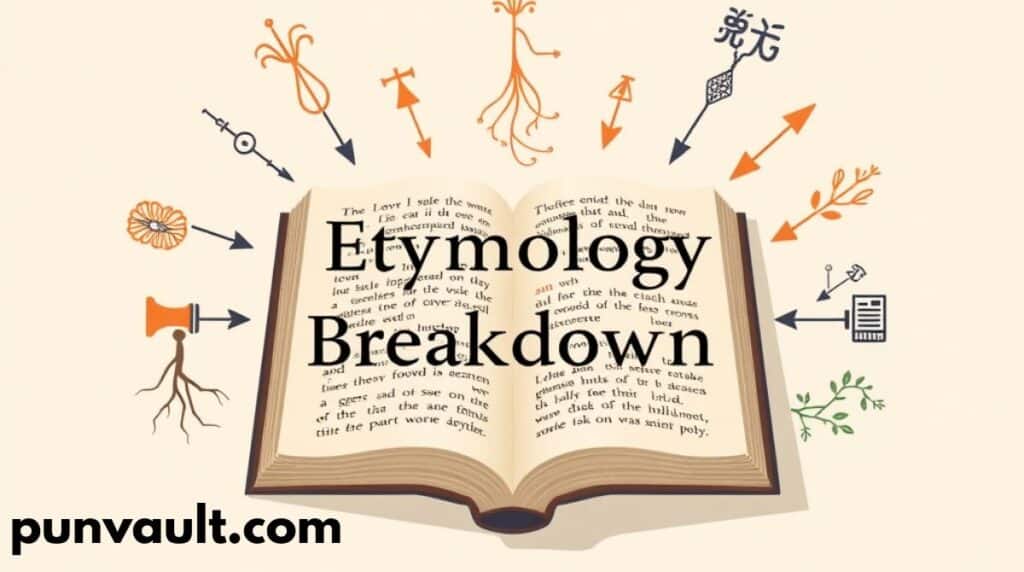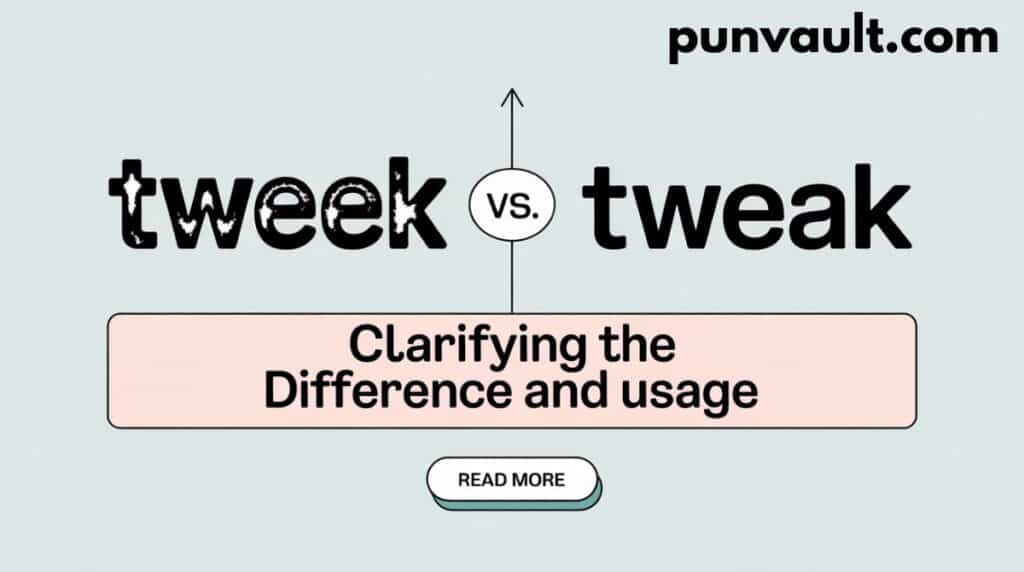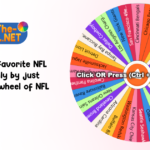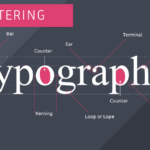Tweek vs Tweak: Clarifying the Difference and Usage refers to understanding the correct use of the word “tweak” and recognizing “tweek” as a common misspelling. While “tweak” means to make small changes or improvements, “tweek” has no official meaning in English and is often used incorrectly due to phonetic confusion or typing errors. This difference, though minor on the surface, plays a big role in writing accuracy and professionalism.
In today’s fast-paced digital world, even small writing mistakes can hurt your credibility. A single misspelled word like “tweek” instead of “tweak” can make your work seem rushed or careless. That’s why Tweek vs Tweak: Clarifying the Difference and Usage is more than just a grammar point—it’s a reflection of your attention to detail and clarity in communication.
Understanding Tweek vs Tweak: Clarifying the Difference and Usage helps you avoid embarrassing errors in emails, reports, and daily writing. It supports better language habits and builds trust with your readers. Whether in school, business, or casual chats, using the correct word matters.
The Core Difference: Setting the Record Straight
Here’s the truth that’ll save your reputation: “tweak” is the only correct spelling. There’s no debate, no regional variation, no alternative. “Tweek” is simply a misspelling that’s somehow gained traction in digital spaces.
Tweak means making small adjustments to improve something. Whether you’re tweaking a design, adjusting code, or refining your morning routine, this word usage remains consistent across all contexts.
The phonetic similarity between these spellings creates massive confusion. Both sound identical when spoken, leading to what linguists call homophones – words that sound the same but have different meanings or spellings.
Quick Reference Guide
| Correct | Incorrect | Context |
|---|---|---|
| Tweak | Tweek | Professional documents |
| Tweak | Tweek | Technical writing |
| Tweak | Tweek | Casual communication |
| Tweak | Tweek | Creative industries |
The bottom line: Always use “tweak.” No exceptions, no alternatives.
Understanding “Tweak” – More Than Just Minor Adjustments
Tweak carries more weight than most people realize. According to Merriam-Webster, it originated in the 1960s, evolving from the older meaning of “to pinch or pull with a sudden jerk.”
Primary Definition and Modern Usage
Today’s tweak encompasses several distinct meanings:
- Physical adjustments: Tweaking guitar strings for perfect pitch
- Digital modifications: Tweaking code for better performance
- Behavioral changes: Tweaking daily routines for productivity
- Design refinements: Tweaking layouts for user experience
Etymology Breakdown

The word’s journey reveals fascinating insights into English language evolution. Originally meaning a sharp pinch or twist, tweak gradually expanded to represent any small but meaningful adjustment.
Multiple Meanings Explained
Technical contexts dominate modern usage. Software developers tweak algorithms. Graphic designers tweak color palettes. Musicians tweak audio settings. Each represents refinement through careful adjustment.
Business applications showcase the world’s versatility. Marketing teams tweak campaign messages. Operations managers tweak workflows. HR departments tweak policies. These minor edits often produce significant improvements.
Intensity Levels
Tweaking exists on a spectrum:
- Gentle tweaks: Subtle font size adjustments
- Standard tweaks: Reorganizing paragraph structure
- Substantial tweaks: Overhauling entire sections
- Major overhauls: Complete rewrites (technically beyond tweaking)
Understanding these gradations helps you communicate more precisely about the scope of changes needed.
Why “Tweek” Keeps Appearing (And Why It’s Always Wrong)
Autocorrect isn’t helping. Many systems don’t flag “tweak” as incorrect, especially when it appears in casual contexts. This autocorrect failure perpetuates misspelling across digital platforms.
The South Park Factor
South Park introduced a character named Tweek Tweak – notice the deliberate misspelling in the first name. This pop culture reference confuses people about acceptable spelling variations. However, formal writing standards remain unchanged.
Visual Similarity Patterns
Our brains process spelling through pattern recognition. Words like “week,” “seek,” and “peek” end in “-eek.” This visual familiarity makes “tweek” seem plausible, even though it breaks English language rules.
Internet Culture Influence
Social media platforms amplify spelling errors. Viral posts containing “tweek” spread faster than corrections. Memes and casual online communication normalize incorrect spelling, creating false legitimacy.
Regional Variations Myth
No English language variant accepts “tweek” as correct. British, American, Canadian, and Australian dictionaries all specify “tweak.” Claims of regional acceptance are simply false.
Real-World Applications: Where “Tweak” Dominates
Tech Industry Standards
Technology sectors demand precision. Software engineers tweak algorithms daily. UX designers tweak interfaces for a better user experience. System administrators tweak configurations for optimal performance.
Programming documentation exclusively uses “tweak.” Code comments, technical specifications, and software manuals maintain this spelling accuracy. Deviating from standard spelling in tech environments signals unprofessionalism.
READ MORE:145+ Knee Replacement Jokes To Laugh Your Way to Better Mobility
Business Communication Excellence

Professional communication requires spelling accuracy. Email correspondence, business proposals, and reports all benefit from proper word usage. Clients notice spelling errors, affecting their perception of professionalism.
Workplace communication standards increasingly emphasize writing precision. Human resources departments track communication skills during performance reviews. Minor spelling mistakes can impact career advancement.
Creative Fields Leadership
Graphic design professionals tweak layouts constantly. Music production involves tweaking audio levels. Photo editing requires tweaking the color balance. These industries built their vocabulary around precise word usage.
Creative writing demands spelling accuracy above all else. Editors immediately flag misspellings like “tweek.” Publishers maintain strict spelling standards across all materials.
Personal Development Applications
Productivity experts discuss tweaking habits for better outcomes. Lifestyle coaches recommend tweaking routines gradually. Self-improvement literature consistently uses correct spelling to maintain credibility.
Academic writing in psychology and behavioral sciences extensively uses “tweak” when discussing minor adjustments to research methodologies or intervention strategies.
The Professional Cost of Getting It Wrong
Spelling errors damage professional reputation more than most people realize. Research consistently shows that misspellings undermine credibility and trustworthiness.
Credibility Damage Assessment
Studies reveal that spelling mistakes reduce perceived intelligence by up to 40%. Clients question competence when they spot typos in professional documents. Business relationships suffer when communication contains errors.
Financial services report losing clients due to spelling errors in proposals. Consulting firms track proposal success rates against spelling accuracy – the correlation is striking.
Industry-Specific Impacts
The legal profession demands absolute spelling accuracy. Court documents containing misspellings can be rejected. Contracts with spelling errors create legal vulnerabilities.
Medical field connections between spelling and patient safety are documented. Prescription errors sometimes stem from misspellings. Medical records require precise terminology.
Education sector teachers and administrators face credibility challenges when spelling errors appear in communications with parents or students. Academic reputation depends on writing precision.
MORE: Good Roasts For Bullies: 50+ Clever Comebacks That Actually Work
Digital Footprint Effects

Online presence amplifies spelling mistakes. Social media posts, professional profiles, and digital portfolios remain searchable indefinitely. SEO rankings can suffer from spelling inconsistencies.
Professional networking platforms like LinkedIn showcase writing skills through posts and comments. Recruiters notice spelling patterns when evaluating candidates.
Beyond Spell-Check: Mastering Similar Confusions
Sound-Alike Word Patterns
English language contains numerous homophone pairs that create spelling confusion:
- Peak vs. Peek vs. Pique: Mountain tops, quick looks, and aroused interest
- Affect vs. Effect: Influence versus result
- Compliment vs. Complement: Praise versus completion
Understanding these patterns helps prevent similar mistakes across your writing.
Double Letter Traps
Spelling rules for double letters often seem arbitrary. “Tweak” follows standard patterns, while “tweek” doesn’t. Learning these patterns prevents future errors.
Common double-letter words include:
- Necessary (not “necessary”)
- Accommodate (not “accommodate”)
- Occurrence (not “occurence”)
Context Clues for Verification
Surrounding words provide spelling hints. Technical contexts almost always require a “tweak.” Creative writing about adjustments uses “tweak.” Business communication discussing improvements needs a “tweak.”
Professional Editing Techniques
Professional editors use systematic approaches:
- Read aloud to catch phonetic errors
- Reverse reading to spot spelling mistakes
- Digital tools for initial screening
- Manual review for context accuracy
- Peer review for fresh perspectives
Memory Tricks for Lasting Accuracy
Mnemonic devices help remember correct spelling:
- “Tweak” contains “weak” – both describe minor changes
- “Tweek” sounds like “week,” but weeks don’t adjust things
- “Tweak” rhymes with “peak” – both achieve optimization
The Ripple Effect: How Small Corrections Create Big Changes
Compound Improvements
Spelling accuracy improvements cascade through organizations. Teams that prioritize precision develop higher standards across all communication. Quality improvements become habitual.
Customer service departments report better client relationships when spelling accuracy improves. Clear communication reduces misunderstandings and builds trust.
READ MORE:104+ Heartfelt Ways to Say ‘Thank You for Your Friendship’
Team Communication Enhancement
Workplace culture reflects writing standards. Organizations with high spelling accuracy attract detail-oriented employees. Professional development programs increasingly include writing skills.
Collaborative projects benefit from consistent spelling standards. Shared documents look more professional when everyone maintains accuracy.
Brand Consistency Benefits
Marketing materials gain credibility through spelling accuracy. Brand perception suffers when misspellings appear in advertisements or promotional content. Consistency builds trust.
Social media management requires constant attention to spelling. Viral posts with errors can damage brand reputation permanently.
Future-Proofing Your Writing: Advanced Strategies
AI Tool Integration
Modern editing tools like Grammarly and Hemingway Editor catch spelling errors effectively. However, human oversight remains essential for context accuracy.
Microsoft Word Editor provides real-time spelling checks, but customization improves accuracy. Adding industry-specific terms to personal dictionaries prevents false flags.
Industry-Specific Dictionaries

Professional fields develop specialized vocabulary. Legal writing requires legal terminology. Medical writing demands medical spelling accuracy. Technical writing needs technical precision.
Building personal dictionaries for your industry improves efficiency and accuracy. Regular updates keep terminology current.
Continuous Learning Approaches
Language evolves constantly. New terms enter dictionaries regularly. Professional writers stay updated through industry publications and style guides.
Online resources provide real-time spelling guidance. Dictionary websites offer pronunciation guides and usage examples.
Feedback Loop Systems
Organizational writing improves through systematic feedback. Peer review processes catch errors before publication. Regular training sessions address common mistakes.
Client feedback reveals communication effectiveness. Tracking spelling accuracy helps identify improvement areas.
Actionable Takeaways: Your Next Steps
Immediate Fixes
Update your autocorrect dictionary today. Add “tweak” to your blocked words list. Set “tweak” as the preferred spelling.
Review recent documents for spelling errors. Replace any instances of “tweak” with “tweak.” Update templates and style guides.
Weekly Habits
Dedicate time each week to proofreading practice. Read professional publications to reinforce correct spelling patterns. Practice writing with challenging vocabulary.
Schedule regular reviews of your writing tools. Update software dictionaries and customize settings for your industry.
Professional Development
Invest in writing courses that emphasize spelling accuracy. Join professional writing organizations for continuing education. Attend workshops on business communication.
Consider hiring professional editors for important documents. The cost is minimal compared to potential credibility damage.
Team Implementation
Establish organization-wide spelling standards. Create style guides that address common confusions. Provide training sessions on professional writing.
Implement review processes for external communications. Designate proofreading responsibilities within teams. Celebrate improvements in writing quality.
Measurement Strategies
Track spelling accuracy improvements over time. Monitor client feedback about communication quality. Measure the impact of writing improvements on business outcomes.
Document best practices that work for your organization. Share success stories to motivate continued improvement.
Final Thoughts
In summary, Tweek vs Tweak: Clarifying the Difference and Usage is about knowing the correct spelling and meaning of “tweak.” “Tweak” means to make a small change or adjustment. On the other hand, “tweek” is just a common spelling mistake. Using the right word shows attention to detail and improves your writing. It also helps your message stay clear and professional.
Understanding Tweek vs Tweak: Clarifying the Difference and Usage is important in both personal and work communication. A small spelling error can change how people see your message—and you. tweek vs tweak. By learning the correct form, you can avoid confusion and write with more confidence. Every word matters, even the small ones.
FAQs
1. What does “tweak” mean?
To make a small adjustment or fine‐tune something for better performance or clarity.
2. Is “tweek” a real word?
No, “tweek” is simply a misspelling of “tweak” and has no formal meaning in English.
3. Why do people often type “tweak”?
It often happens due to phonetic confusion, fast typing, or autocorrect mistakes.
4. Where is avoiding “tweak” most important?
In professional writing—like emails, reports, or proposals—using “tweak” correctly boosts credibility.
5. How can I avoid using “tweak” by mistake?
Use spell‑check tools like Grammarly or Microsoft Word, and proofread your text slowly.

Carlos Wise is the undisputed king of comebacks and the master of roast-worthy wit. With a sharp tongue and a sharper sense of humor, he crafts savage one-liners and hilarious insults that leave no mic un-dropped. When he’s not penning legendary burns, Carlos is busy decoding the art of sarcasm and turning everyday moments into comedy gold. If you’re looking for a laugh with bite, Carlos delivers every time.







